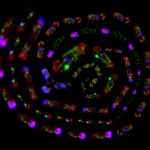Lien vers Pubmed [PMID] – 12582231
Nucleic Acids Res. 2003 Feb;31(4):1121-35
As part of the exploratory sequencing program Génolevures, visual scrutinisation and bioinformatic tools were used to detect spliceosomal introns in seven hemiascomycetous yeast species. A total of 153 putative novel introns were identified. Introns are rare in yeast nuclear genes (<5% have an intron), mainly located at the 5' end of ORFs, and not highly conserved in sequence. They all share a clear non-random vocabulary: conserved splice sites and conserved nucleotide contexts around splice sites. Homologues of metazoan snRNAs and putative homologues of SR splicing factors were identified, confirming that the spliceosomal machinery is highly conserved in eukaryotes. Several introns' features were tested as possible markers for phylogenetic analysis. We found that intron sizes vary widely within each genome, and according to the phylogenetic position of the yeast species. The evolutionary origin of spliceosomal introns was examined by analysing the degree of conservation of intron positions in homologous yeast genes. Most introns appeared to exist in the last common ancestor of present day yeast species, and then to have been differentially lost during speciation. However, in some cases, it is difficult to exclude a possible sliding event affecting a pre-existing intron or a gain of a novel intron. Taken together, our results indicate that the origin of spliceosomal introns is complex within a given genome, and that present day introns may have resulted from a dynamic flux between intron conservation, intron loss and intron gain during the evolution of hemiascomycetous yeasts.

